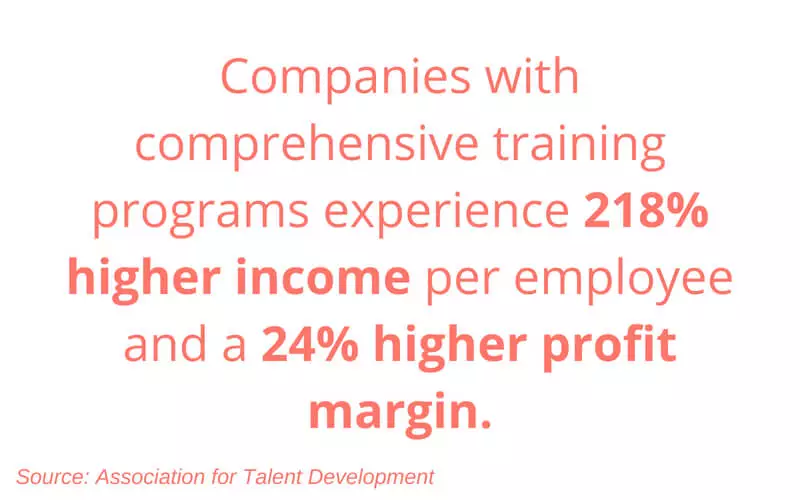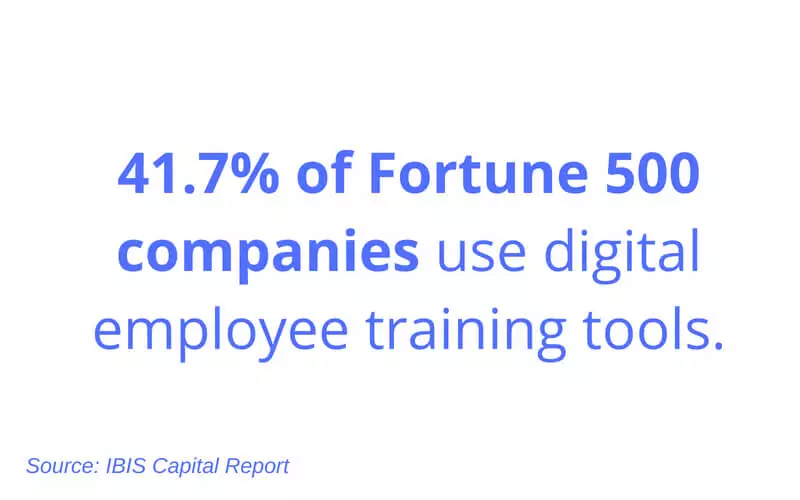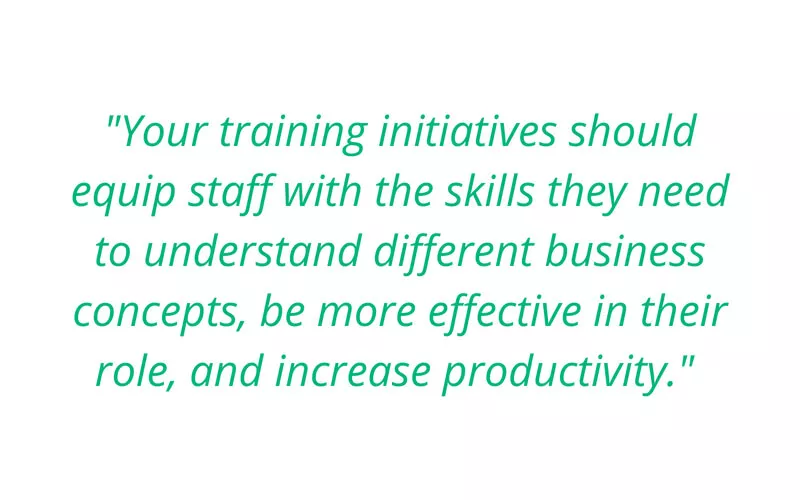You are seeking a competitive advantage, and let’s face it — who isn’t? The best way to differentiate your business is to make talent development your top priority.
The best way to achieve this is by improving your employee training process. In the digital workplace, proper training is more vital to success than ever before. With an effective employee training process, you’ll realize higher productivity, greater efficiency, a more engaged culture, and overall better business performance.
Like Jack Welch said, “An organization’s ability to learn, and translate that learning into action rapidly is the ultimate competitive advantage.”
 If you’re seeking inspiration to improve your employee training program, these statistics from the Association for Talent Development (ATD) will astound you.
Companies that provide comprehensive training programs have a 218% higher income per employee than those that don’t have formal training. They also experience a 24% higher profit margin. If these numbers aren’t enough encouragement I don’t know what will be.
If you’re seeking inspiration to improve your employee training program, these statistics from the Association for Talent Development (ATD) will astound you.
Companies that provide comprehensive training programs have a 218% higher income per employee than those that don’t have formal training. They also experience a 24% higher profit margin. If these numbers aren’t enough encouragement I don’t know what will be.
 There is strong evidence to suggest incorporating modern technology is the route to success.
Take the IBIS Capital Report for example, which shows 41.7% of Fortune 500 companies use digital tools to train staff. Given this data is from some of the most influential companies in the world, it’s safe to assume this is a successful trend to follow.
Many companies have already experienced positive results from digital training tools. For example, solutions that enable contextual learning are a proven choice. With contextual learning, employees easily adopt new processes and features while receiving real-time guidance. The end result is shorter time-to-competence, higher productivity, and greater knowledge retention.
There is strong evidence to suggest incorporating modern technology is the route to success.
Take the IBIS Capital Report for example, which shows 41.7% of Fortune 500 companies use digital tools to train staff. Given this data is from some of the most influential companies in the world, it’s safe to assume this is a successful trend to follow.
Many companies have already experienced positive results from digital training tools. For example, solutions that enable contextual learning are a proven choice. With contextual learning, employees easily adopt new processes and features while receiving real-time guidance. The end result is shorter time-to-competence, higher productivity, and greater knowledge retention.
 Your training initiatives should equip staff with the skills they need to understand different business concepts, be more effective in their role, and increase productivity. If you can create a roadmap prioritizing these needs, employees will acquire the skills they need to be successful.
Your roadmap should identify pain points and problem areas that need to be addressed. This will help you devise realistic expectations from your employee training process, in terms of business objectives and employee learning and development.
Your approach should be customized based on individual needs, where different departments need to learn different things. Your learning program should be tailored accordingly, assessing where you can customize and personalize training resources.
Your training initiatives should equip staff with the skills they need to understand different business concepts, be more effective in their role, and increase productivity. If you can create a roadmap prioritizing these needs, employees will acquire the skills they need to be successful.
Your roadmap should identify pain points and problem areas that need to be addressed. This will help you devise realistic expectations from your employee training process, in terms of business objectives and employee learning and development.
Your approach should be customized based on individual needs, where different departments need to learn different things. Your learning program should be tailored accordingly, assessing where you can customize and personalize training resources.
Boost your employee training and process and watch productivity soar.
Quantifying the value of effective employee training
 If you’re seeking inspiration to improve your employee training program, these statistics from the Association for Talent Development (ATD) will astound you.
Companies that provide comprehensive training programs have a 218% higher income per employee than those that don’t have formal training. They also experience a 24% higher profit margin. If these numbers aren’t enough encouragement I don’t know what will be.
If you’re seeking inspiration to improve your employee training program, these statistics from the Association for Talent Development (ATD) will astound you.
Companies that provide comprehensive training programs have a 218% higher income per employee than those that don’t have formal training. They also experience a 24% higher profit margin. If these numbers aren’t enough encouragement I don’t know what will be.
Outdated methods fail to engage employees
Traditional training methods are still used despite the changing landscape of the digital workplace. The training sector has been forced to innovate and reinvent in line with technological advancements, but on-site, in-person training unfortunately still plays a huge role. One aspect of importance, regardless of method, is maintaining a relevant offering in the modern market. There is one common denominator in all of this: engagement. If you can engage learners effectively, they’ll be more likely to retain valuable information. A Dale Carnegie survey suggests engaged employees outperform others by up to 202%! To increase engagement and boost the success of your employee training process, check out the following four tips.1. Utilize modern technology
 There is strong evidence to suggest incorporating modern technology is the route to success.
Take the IBIS Capital Report for example, which shows 41.7% of Fortune 500 companies use digital tools to train staff. Given this data is from some of the most influential companies in the world, it’s safe to assume this is a successful trend to follow.
Many companies have already experienced positive results from digital training tools. For example, solutions that enable contextual learning are a proven choice. With contextual learning, employees easily adopt new processes and features while receiving real-time guidance. The end result is shorter time-to-competence, higher productivity, and greater knowledge retention.
There is strong evidence to suggest incorporating modern technology is the route to success.
Take the IBIS Capital Report for example, which shows 41.7% of Fortune 500 companies use digital tools to train staff. Given this data is from some of the most influential companies in the world, it’s safe to assume this is a successful trend to follow.
Many companies have already experienced positive results from digital training tools. For example, solutions that enable contextual learning are a proven choice. With contextual learning, employees easily adopt new processes and features while receiving real-time guidance. The end result is shorter time-to-competence, higher productivity, and greater knowledge retention.
Flexibility
This is important when staff can’t afford to spend too much time away from their core responsibilities. Online training offers the flexibility of remote engagement, generating additional saving on materials, instructional costs, and travel expenses.Track Performance
Online platforms allow you to effectively track progress so you can evaluate not only performance but the learning process itself. You can consequently identify areas of weakness, and provide structured feedback for staff.Active Participation
With visually appealing, interactive content, your staff is considerably more likely to retain information. The motivation for training increases, and because knowledge is more likely to stick, there are better implications for the long-term with regards to improved performance.2. Create a roadmap
 Your training initiatives should equip staff with the skills they need to understand different business concepts, be more effective in their role, and increase productivity. If you can create a roadmap prioritizing these needs, employees will acquire the skills they need to be successful.
Your roadmap should identify pain points and problem areas that need to be addressed. This will help you devise realistic expectations from your employee training process, in terms of business objectives and employee learning and development.
Your approach should be customized based on individual needs, where different departments need to learn different things. Your learning program should be tailored accordingly, assessing where you can customize and personalize training resources.
Your training initiatives should equip staff with the skills they need to understand different business concepts, be more effective in their role, and increase productivity. If you can create a roadmap prioritizing these needs, employees will acquire the skills they need to be successful.
Your roadmap should identify pain points and problem areas that need to be addressed. This will help you devise realistic expectations from your employee training process, in terms of business objectives and employee learning and development.
Your approach should be customized based on individual needs, where different departments need to learn different things. Your learning program should be tailored accordingly, assessing where you can customize and personalize training resources.

